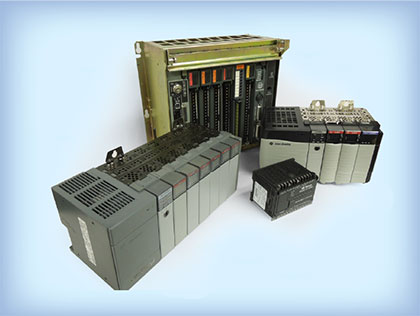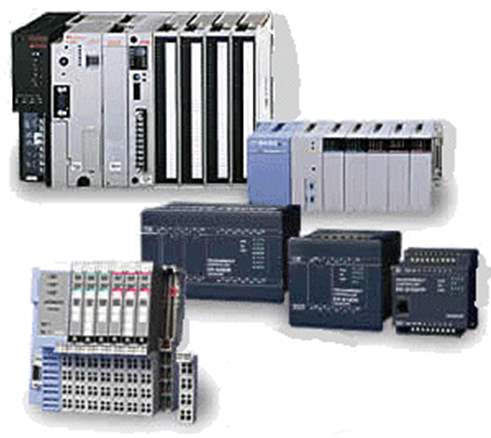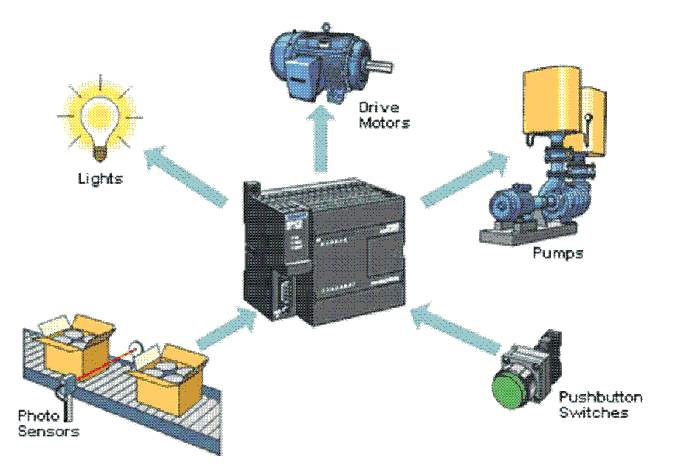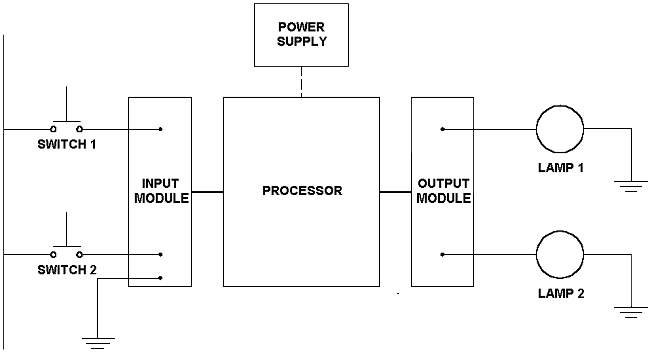
Programmable Logic Controllers (PLCs) have become an integral part of the industrial environment. As a technician involved with the processes controlled by PLCs, it is important to understand their basic functionalities and capabilities.
A programmable logic controller (PLC) is a digital computer used for automation of electromechanical processes, such as control of machinery on factory assembly lines, amusement rides, or lighting fixtures. PLCs are used in many industries and machines. Unlike general-purpose computers, the PLC is designed for multiple inputs and output arrangements, extended temperature ranges, immunity to electrical noise, and resistance to vibration and impact. Programs to control machine operation are typically stored in battery-backed or non-volatile memory. A PLC is an example of a real time system since output results must be produced in response to input conditions within a bounded time, otherwise unintended operation will result. Figure 1 shows a graphical depiction of typical PLCs.

Figure 1: Typical PLCs

Figure 2: Examples of Hardware PLCs Control
History of the PLC
PLC invention was in response to the needs of the American automotive manufacturing industry where software revision replaced the re-wiring of hard wired, relay-based control panels when production models changed.
Before the PLC, control, sequencing, and safety interlock logic for manufacturing automobiles relied on hundreds or, in some instances, thousands of relays, cam timers, and drum sequencers and dedicated closed-loop controllers. The process for updating such facilities for the yearly model change-over was very time consuming and expensive, as electricians needed to individually and manually rewire each and every relay.
In 1968, GM Hydramatic issued a request for an electronic replacement for hard-wired relay systems. The winning proposal came from Bedford Associates of Bedford, Massachusetts. The first PLC, designated the 084 because it was Bedford Associates’ eighty-fourth project, was the result. Bedford Associates started a new company dedicated to developing, manufacturing, selling, and servicing this new product: MODICON, which stood for MOdular DIgital CONtroller. One of the people who worked on that project was Dick Morley, the “father” of the PLC.
In other industries, PLCs replaced relay systems used in manufacturing applications. This eliminated the high cost of maintaining these inflexible systems. In 1970, with the innovation of the microprocessor, the machine that was originally used as a relay replacement device only, evolved into the advanced PLC of today.
Advantages of PLCs
There are six major advantages of using PLCs over relay systems as follows:
- Flexibility
- Ease of troubleshooting
- Space efficiency
- Low cost
- Testing
- Visual operation
Flexibility: One single PLC can easily run many machines.
Ease of Troubleshooting: Back before PLCs, wired relay-type panels required time for rewiring of panels and devices. With PLC control, any change in circuit design or sequence is as simple as retyping the logic. Correcting errors in PLC is both fast and cost effective.
Space Efficient: Fewer components are required in a PLC system than in a conventional hardware system. The PLC performs the functions of timers, counters, sequencers, and control relays, so these hardware devices are not required. The only field devices that are required are those that directly interface with the system such as switches and motor starters.
Low Cost: Prices of PLCs vary from a few hundred to a few thousand. This is minimal compared to the prices of the contact, coils, and timers that companies pay to match the same things. Using PLCs also saves on installation cost and shipping.
Testing: A PLC program can be tested, evaluated, and validated in a lab prior to implementation in the field.
Visual observation: When running a PLC program, a visual operation displays on a screen or module mounted status lamps assist in making troubleshooting a circuit quick, easy, and relatively simple.
Components of a PLC
All PLCs have the same basic components. These components work together to bring information into the PLC from the field, evaluate that information, and send information back out to various field. Without any of these major components, the PLC will fail to function properly.
The basic components include a power supply, central processing unit (CPU or processor), co-processor modules, input and output modules (I/O), and a peripheral device.

Figure 3: PLC Components
For detailed information on PLCs, visit our free Industrial Wiki or contact us at sales@techtransfer.com to set up a class at your facility.

